Rule makers may introduce partial aggregation of the look-through requirement for Pillar I SCR calculation in the standard formula, Solvency II Wire can reveal. According to a source close to the discussions in Frankfurt, rule makers are considering a proposal to allow undertakings that hold less than 20% of their total assets in collective investment funds to treat these funds on an aggregated basis for the SCR calculations. Any collectives in excess of the 20% would be treated on a full look-through basis (line-by-line). The proposal relates to Pillar I SCR calculations only, and does not affect Pillar III disclosures.
Home » Knowledge Base » Look-through » Solvency II News: regulators consider easing Solvency II look-through






1 thought on “Solvency II News: regulators consider easing Solvency II look-through”
Comments are closed.